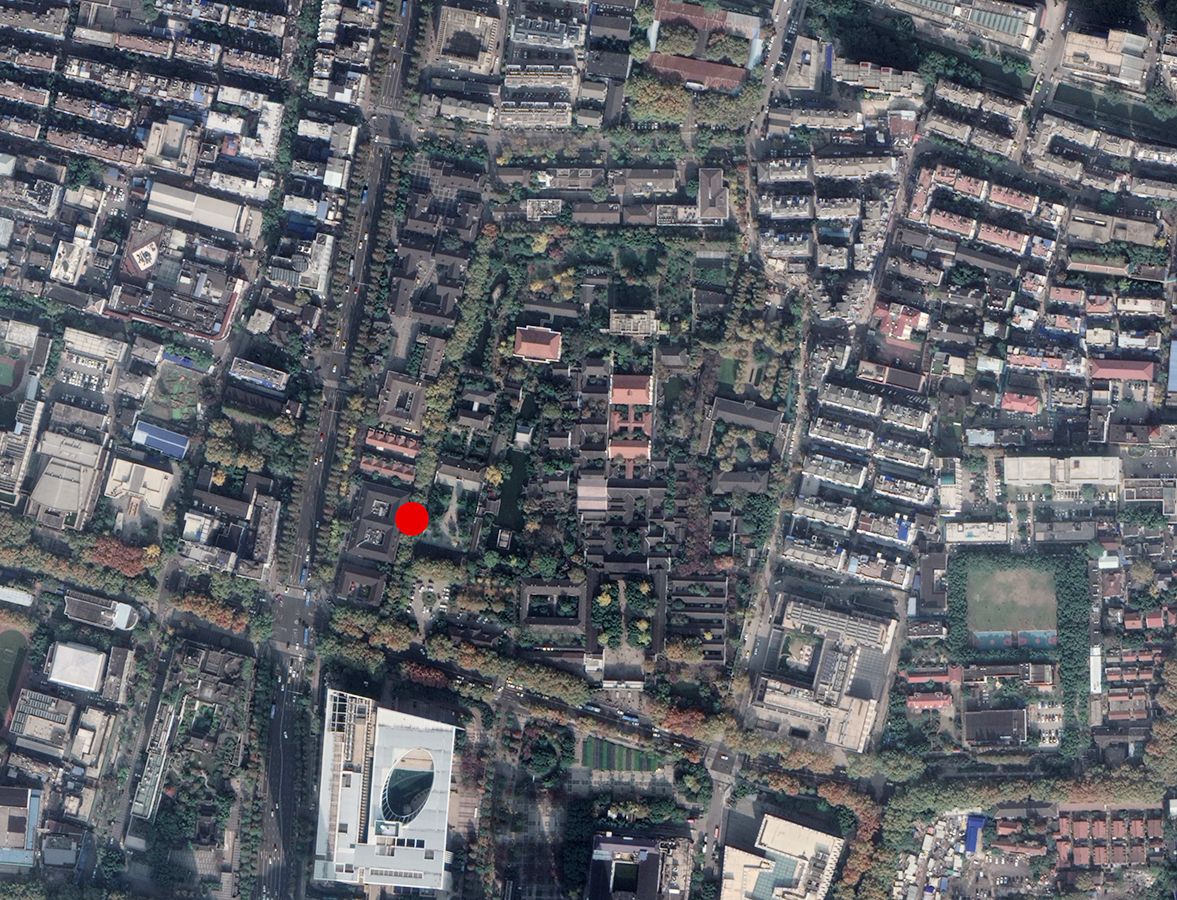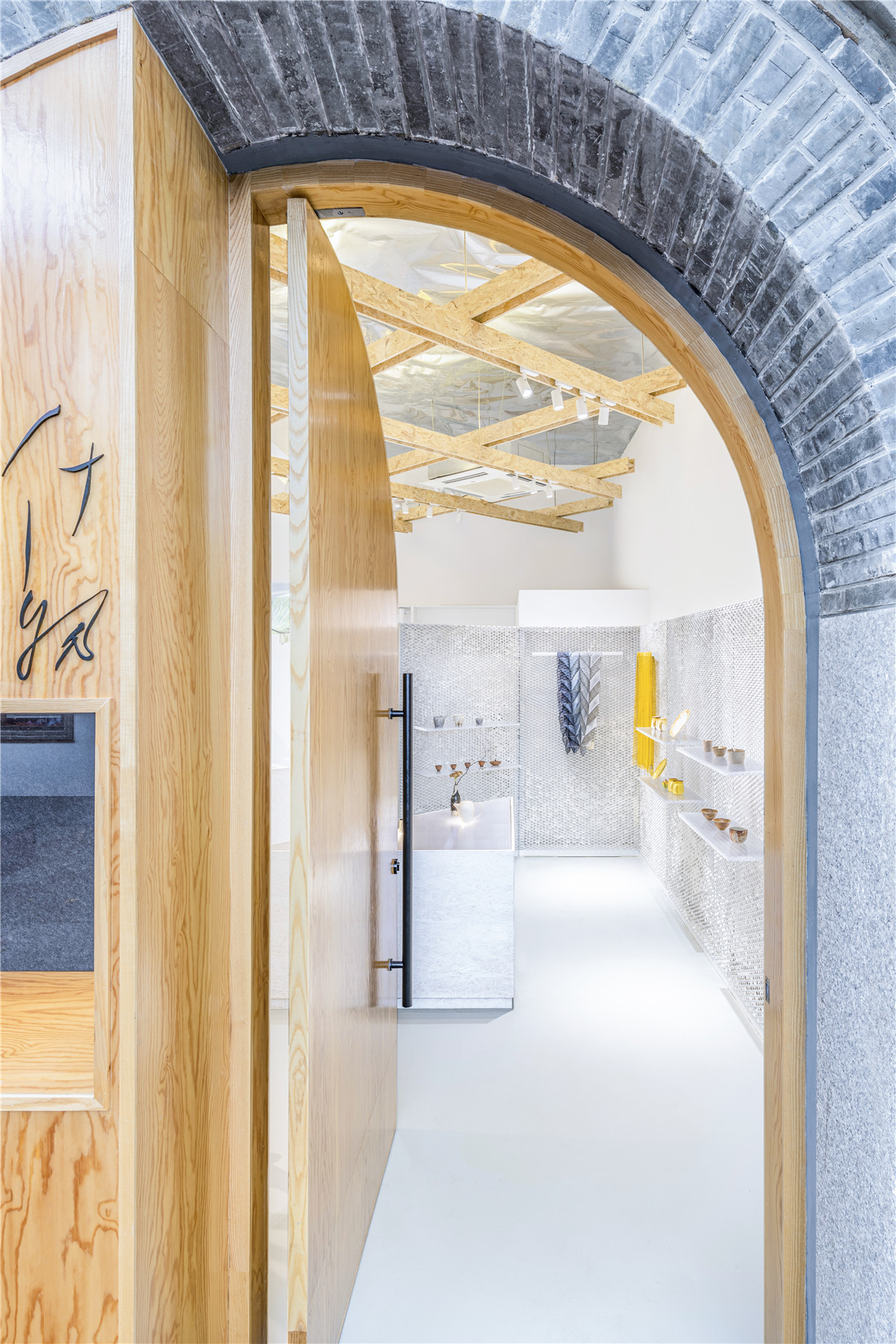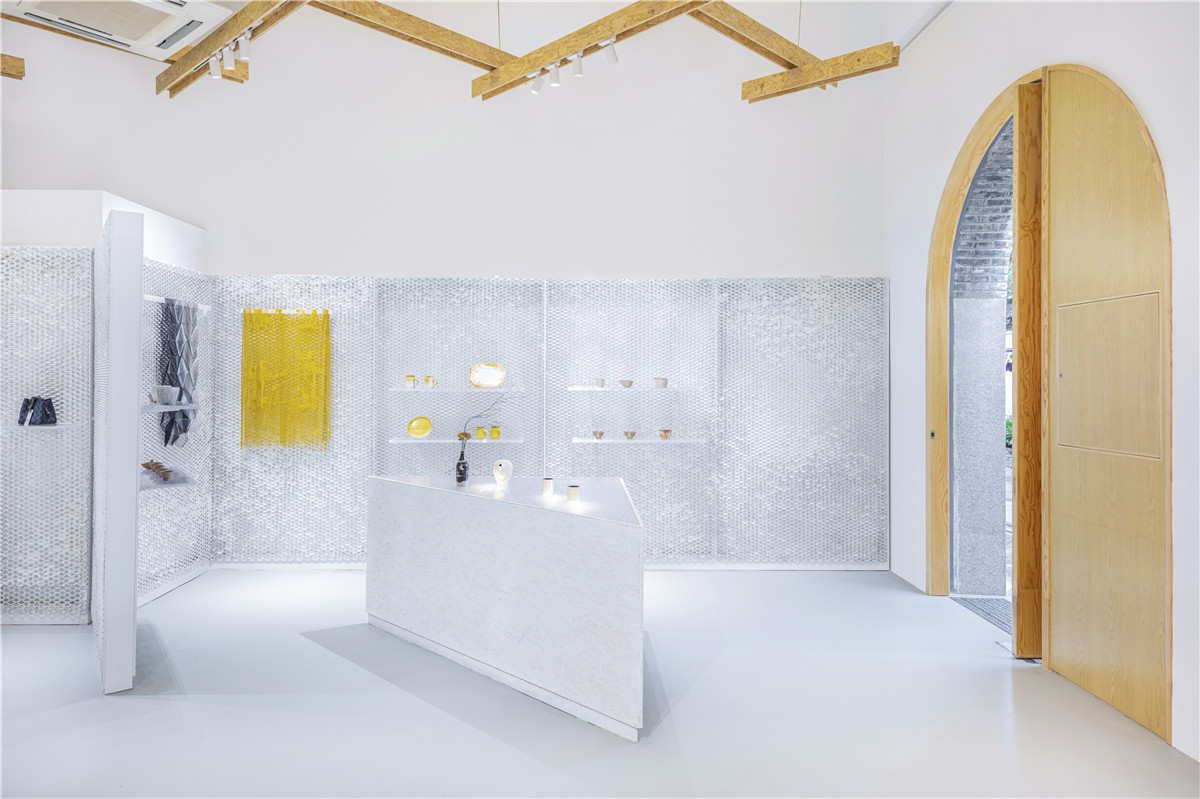什物是一家以销售精致生活方式相关的日本产品为主的商店,位于南京总统府旧址旁。其商品涵盖器皿、女装、配饰等类型的手艺人定制作品。委托人经历过日本的泡沫经济时期,时代的沉浮让她更能读懂匠人的以物传情,并以传播者的视角传递手作的情绪。与此相似,CATS的设计也是探索手作精神在空间体验和材料氛围上的再表达。
Located along a narrow alley next to the Presidential Palace, a cultural heritage and popular tourist destination in Nanjing, the new Shiwu branch store is provided a context that is not to the advantage of its own character. While the surroundings embrace loud crowds, cheap souvenirs and fast food, Shiwu primarily features carefully crafted products that are mostly handmade by Japanese craftsmen.
网Web
▲网墙使用灵活性示意
▲网墙序列
▲网墙陈列细节
什物的商品种类繁杂,形式各异,并且更替频繁。如何巧妙的应对商品的多样和多变?是否有机会只做一个简单的操作而同时解决多个问题?答案也许并不难发现——植入可以灵活挂装的墙面。传承自隈研吾先生的材料探索精神,我们选用了定制孔径的张拉铝网,并用纸絮挂浆包裹其表面。张拉铝网孔径与常规金属托架产品的孔距相对应,其拼合而成的墙面允许托架在任意位置安装(现了最大程度的灵活)。同时,经过大量调研和试验,我们找到中国古法造纸所采用的原浆纸浆,发现其纸絮长并且附着力很强。我们以试验得出的合适比例将其溶入水池,在现场亲手完成了20张铝网的挂浆、晾晒。
Maximizing the flexibility of rearrangement through a single intervention, we tested early on the idea of inserting partitions cladded with expanded mesh. We carefully selected a custom aperture dimension, which best fit commonly available standardized hangers, so that there could be no limit in terms of where the objects or shelves could be fixed. In the spirit of Kengo Kuma’s material experimentation, we went on to look for a fitting twist to the harshness of metal mesh. After going through many surveys and experiments, we discovered an ancient Chinses formula of paper pulp, which is very fiber rich and adhesive. Before execution on site, we tested to control the level of transparency of pulp web in our studio. We then dipped and dried 20 sheets of metal mesh on the construction site by ourselves.
▲张拉铝网挂浆制作过程
纸絮网墙坚固,灵活,透明,斑驳,多变,时而封闭,时而通透,既是功能理性的产物,也有独特的美学,是空间硬件上最有表现力的主元素。
The appearance of these pulp webs is constantly oscillating, due to the unevenness of pulp attachment to the metal meshes. Depending on where the viewer is standing, these webs will look rigid or soft, blurred or transparent, closed or open. They are initiated for the functional flexibility of rearrangement, but perform aesthetic values, giving the space its most unique character.
巾 Textile
▲玲子作品区
▲器皿桌
店内最主要的产品之一是日本布衣家须藤玲子的布料作品(须藤玲子是日本著名的布料大师,作品在 上世纪90 年代已被 纽约MOMA 收藏)。委托人与玲子私交甚好,提出空间用作玲子作品展览的营运需求。 出于对玲子布艺表现力的尊重,我们将其大型布品整合在空间设计中,布品可灵活悬挂在OSB板制成的1.4m x 1.4m网格矩阵下,使其成为划分空间的软隔断。商品成为隔断,隔断也成为商品。满铺的网格矩阵内均藏有不锈钢吊杆,当举办玲子布品的集中展览时,便于布料的灵活挂装。
Alternative to the everyday operation, the owner also intends to hold occasional exhibitions for Japanese artist Reiko Sudo’s textile works. We use a 1.4 x 1.4m lattice grid of OSB strips to realize the hanging of larges pieces of Sudo’s fabrics that could also perform as soft partitions of the space.
▲功能吊顶
暗藏于吊顶网格矩阵内的LED灯带,经顶面褶皱的铝箔漫反,投下柔和均质的暖白光,营造明亮舒适的氛围并减弱影响购物体验的暗影。
The upper side of the lattice grid contains LED strips illuminating upwards onto a reflective ceiling that is made out of 1mm galvanized steel sheet. This system provides evenly distributed brightness flooding over the floor, improving visual comfort and diffusing unpleasant shadows.
市Linger
▲什物所在地
▲入口大门
▲入口区
什物选址在南京游人如织的1912商业街,却试图反其道而行之,将门做实,愿意推开门的客人才有机会看到内里的别有洞天。这样一次倔强的筛选,使什物和周边针对游客的小商品零售相区分,凸显其品牌定位。有别于在线购物,什物需要能够丰富进店顾客的购物体验。网墙在平面上以45度扭转呈现,并逐级升高,鼓励顾客自在绕行其间,在入口区挑选器皿,在相对私密的抬高区尝试服装。另外,在吧台旁的地柜与台阶交汇处的角落,围合出休息区,方便店主不定期举办小型活动,增加老客的到店频次。
We decided early on to focus on the introverted spatial quality of the store. It welcomes the visitors to come inside, but examines their curiosities through a solid wooden door. The gesture of pulling distinguishes the shop from its touristic neighbors, and reveals its internal quiet and relaxed atmosphere in an unanticipated manner. For enriching the visitors’ shopping experience, we endeavored to increase their circulations and turns with a 45-degree angled layout. Circling around at wish, they may pick up pottery objects at the entry, or try on clothes at the elevated, more private zone. They may as well sit down at an angled corner and enjoy a cup of tea.
▲收银台视角
近年的零售空间设计很多堆砌了浮夸的视觉元素,往往形式大于内容。这似乎呈现的是实体面对网购挑战的无力。而什物仍然在为营造传递人心的空间而努力,力求构建造物者与使用者之间的桥梁。从委托人面临问题的自身潜力出发,CATS一直力求探索功能空间和材料运用的新可能,以此传达审美和情绪至使用者之心。我们以匠心回应匠心,为“后网红时代”的零售空间打样。
While retail design is now often seen to focus on superficial cyber popularity, imposing exaggerated visual elements, our effort in Shiwu is to rediscover the quality and potential in craftsmanship, encouraging tactile sensation, lingering, and looking around.
▲模型
▲平面图
▲内立面图
项目信息——
项目名称:什物物品店
设计方:CATS顾问建筑师小组
项目设计 & 完成年份:2019
主创及设计团队:黄文心、陈胜泽、陈雪丽
项目地址:南京总统府1912
建筑面积:80平
摄影版权:Dirk Weiblen
施工:林成喜,程家朝
定制材料:张拉铝网、纸浆、阳光板、旋切松木板
Project information——
Project name:Shiwu Store
Design:CATS
Design year & Completion Year:2019
Leader designer & Team:Wenxin Huang、Shengze Chen、Xueli Chen
Project location:Presidential Palace, Nanjing
Gross Built Area:80sqm
Photo credits:Dirk Weiblen
Contractor:Chengxi Lin、Jiachao Cheng
Custom made material:Expanded mesh、Paper pulp、Pine wood composite board

























